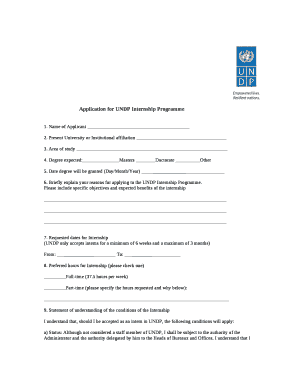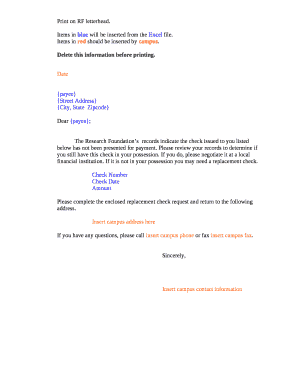
Get the free us 1040 form
Show details
Form Department of the Treasury 1040 Internal Revenue Service U.S. Individual Income Tax Return For the year Jan 1 Dec 31, 2005, or other tax year beginning Label (See instructions.) Your first name
We are not affiliated with any brand or entity on this form
Get, Create, Make and Sign

Edit your us 1040 form form online
Type text, complete fillable fields, insert images, highlight or blackout data for discretion, add comments, and more.

Add your legally-binding signature
Draw or type your signature, upload a signature image, or capture it with your digital camera.

Share your form instantly
Email, fax, or share your us 1040 form form via URL. You can also download, print, or export forms to your preferred cloud storage service.
Editing us 1040 online
In order to make advantage of the professional PDF editor, follow these steps below:
1
Log in. Click Start Free Trial and create a profile if necessary.
2
Prepare a file. Use the Add New button to start a new project. Then, using your device, upload your file to the system by importing it from internal mail, the cloud, or adding its URL.
3
Edit 1040 u s individual income tax return form. Rearrange and rotate pages, add and edit text, and use additional tools. To save changes and return to your Dashboard, click Done. The Documents tab allows you to merge, divide, lock, or unlock files.
4
Get your file. When you find your file in the docs list, click on its name and choose how you want to save it. To get the PDF, you can save it, send an email with it, or move it to the cloud.
pdfFiller makes dealing with documents a breeze. Create an account to find out!
How to fill out us 1040 form

How to fill out us 1040:
01
Gather all necessary documents such as W-2 forms, 1099 forms, and any other income statements.
02
Calculate your total income by adding up all sources of income, including wages, dividends, and self-employment earnings.
03
Determine your deductions by reviewing the tax code for eligible deductions such as mortgage interest, medical expenses, and educational expenses.
04
Subtract your deductions from your total income to calculate your adjusted gross income (AGI).
05
Determine your tax liability by using the tax tables provided by the IRS or by using tax software.
06
Apply any tax credits you are eligible for, such as the Child Tax Credit or the Earned Income Tax Credit.
07
Calculate your final tax liability by subtracting the tax credits from your tax liability.
08
Compare your final tax liability with any payments you have already made through withholding or estimated tax payments.
09
If you have paid more than your tax liability, you may be eligible for a refund. If you have paid less, you may need to make an additional payment with your tax return.
10
Complete the remaining sections of the 1040 form, such as personal information, filing status, and signing the return.
11
Double-check all calculations and ensure that all information is accurate before submitting your tax return.
Who needs us 1040:
01
Individuals who have earned income from wages, self-employment, or investments are required to file a US 1040 form.
02
Those who meet the minimum income threshold set by the IRS, regardless of the source of income, must file a 1040 form.
03
Married couples filing separately with certain income thresholds, regardless of whether they have earned income, may also need to file a 1040 form.
04
Individuals who wish to claim certain deductions, credits, or refunds are also required to file a 1040 form even if their income is below the minimum threshold.
05
Nonresident aliens who have income from US sources are also required to file a 1040 form in certain circumstances.
06
It is important to consult the IRS guidelines or seek professional advice to determine if you need to file a 1040 form based on your specific financial situation.
Fill form : Try Risk Free
For pdfFiller’s FAQs
Below is a list of the most common customer questions. If you can’t find an answer to your question, please don’t hesitate to reach out to us.
What is us 1040?
The US 1040 form is the standard tax form used by individuals to file their federal income tax returns with the Internal Revenue Service (IRS) in the United States. It is a document that allows taxpayers to report their income, claim deductions and credits, calculate their tax liability or refund, and determine their federal income tax for the year. The form 1040 comes in various versions such as 1040A and 1040EZ, each catering to different types of taxpayers with varying income levels and tax situations.
Who is required to file us 1040?
Generally, individuals with certain income levels and types of income are required to file a U.S. 1040 tax return. The specific filing requirements depend on various factors such as age, filing status, and types of income. Here are some broad guidelines for who may be required to file a U.S. 1040 tax return:
1. Single individuals: If you are single and under the age of 65, you must file a tax return if your gross income is at least $12,550 in 2021. If you are 65 or older, the filing threshold is $14,250.
2. Married individuals: If you are married and filing jointly with your spouse, and both of you are under 65 years old, you must file a tax return if your combined gross income is at least $25,100 in 2021. The threshold increases to $27,400 if both spouses are 65 or older.
3. Head of household: If you are considered the head of household for tax purposes (e.g., unmarried with dependents), you must file a tax return if your gross income is at least $18,800 for 2021. The age requirement varies depending on whether you or your dependents are 65 or older.
4. Dependents: If you are a dependent, the filing requirements are generally lower, and it depends on your specific situation (e.g., earned vs. unearned income).
These are just general guidelines, and several other factors can affect the requirement to file a U.S. 1040 tax return, including self-employment income, other types of income, and certain deductions or credits. It is always recommended to consult the IRS guidelines or a tax professional to determine your specific filing requirement.
How to fill out us 1040?
Filling out the US 1040 form can be a complex process, but here are the general steps to follow:
1. Gather all necessary information and supporting documents such as W-2s, 1099s, receipts, and tax forms from your employer, bank, investment accounts, etc.
2. Determine your filing status (single, married filing jointly, married filing separately, head of household, or qualifying widow(er)).
3. Fill in your personal information, including your name, Social Security number, and address.
4. Calculate your total income by reporting all sources of income on the appropriate lines (e.g., wages, self-employment income, interest, dividends, etc.). You may need to attach additional schedules if you have certain types of income or deductions.
5. Deduct any adjustments to income you qualify for, such as student loan interest, IRA contributions, or self-employment tax.
6. Determine if you will itemize deductions or take the standard deduction. If itemizing, report your eligible expenses on Schedule A (e.g., mortgage interest, medical expenses, charitable donations, etc.). If taking the standard deduction, simply enter the appropriate amount on the 1040 form.
7. Calculate your taxable income by subtracting your deductions from your total income. This will determine the tax bracket you fall into.
8. Consult the tax tables provided in the IRS instructions to calculate your tax liability based on your taxable income and filing status.
9. Report any tax credits you qualify for (e.g., child tax credit, earned income credit), which can help reduce your tax liability.
10. Determine if you owe additional taxes or if you qualify for a refund. If owing, make sure to include payment with your tax return. If obtaining a refund, provide your bank account information for direct deposit or request a paper check.
11. Sign your 1040 form and include any required attachments or schedules.
12. Finally, make a copy of your completed 1040 form and supporting documents for your records before mailing it to the appropriate IRS address or electronically filing it using tax software or an authorized e-file provider.
It is important to note that these steps are meant as a general guide. Depending on your specific financial situation, you may need additional schedules, forms, or guidance from a tax professional.
What is the purpose of us 1040?
The purpose of Form 1040, also known as the U.S. Individual Income Tax Return, is to calculate and report an individual's income taxes owed to the Internal Revenue Service (IRS) in the United States. It is used by U.S. citizens, resident aliens, or certain non-resident aliens who have taxable income or meet other filing requirements. Form 1040 allows taxpayers to report different types of income, claim deductions and credits, and determine the amount of tax owed or the refund they are eligible for.
What information must be reported on us 1040?
On the US Form 1040, the following information must be reported:
1. Filing status: You need to indicate whether you are filing as Single, Married Filing Jointly, Married Filing Separately, Head of Household, or Qualifying Widow(er) with Dependent Child.
2. Personal information: Report your name, Social Security Number (SSN), and other identification details.
3. Income: Report all sources of income, including wages, salary, self-employment income, business income, rental income, investment income, retirement income, unemployment compensation, and any other income received during the tax year.
4. Filing exemptions: Report any exemptions claimed, including yourself, your spouse, dependents, and other eligible dependents.
5. Adjustments to income: Report any deductions you may qualify for, such as contributions to retirement accounts, student loan interest, self-employment taxes, alimony paid, and other deductible expenses.
6. Tax credits: Report any tax credits you qualify for, such as the Child Tax Credit, Earned Income Credit, Education credits, and other applicable credits.
7. Taxes paid: Report any federal income taxes withheld from your paychecks, estimated tax payments made, or any excess taxes paid in the previous year.
8. Other taxes: Report any additional taxes owed, such as self-employment tax, alternative minimum tax, or household employment taxes.
9. Refund or amount owed: Calculate whether you are owed a refund or if you owe additional taxes. Consider any overpayment or underpayment made during the tax year.
10. Bank account information: If you want to receive your refund through direct deposit, provide your bank account details, including account number and routing number.
It's important to note that this list is not exhaustive, and depending on individual circumstances, there may be additional forms, schedules, or attachments required to report specific types of income, deductions, or credits.
When is the deadline to file us 1040 in 2023?
The deadline to file US Form 1040 for the 2022 tax year is typically April 15, 2023. However, please note that tax deadlines can sometimes be adjusted by the Internal Revenue Service (IRS) or influenced by various factors, so it's always advisable to confirm the exact deadline closer to the tax year.
What is the penalty for the late filing of us 1040?
The penalty for late filing of the US 1040 tax form is determined based on two factors: 1) whether you owe taxes or are due a refund, and 2) how late the filing is.
If you owe taxes and fail to file your 1040 by the deadline, you might face a failure-to-file penalty. This penalty is usually 5% of the unpaid taxes for each month or part of a month that the return is late, with a maximum penalty of 25%. However, if you file more than 60 days after the deadline, the minimum penalty could be either $435 or 100% of your unpaid taxes, whichever is smaller.
On the other hand, if you are due a refund, there is generally no penalty for filing your 1040 late. However, if you do not file your return within three years from the original due date, you may lose your eligibility to claim a refund.
It is important to note that if you have a valid reason for not being able to file on time, such as a serious illness or natural disaster, you may be able to request an extension or penalty relief.
Where do I find us 1040?
It's simple with pdfFiller, a full online document management tool. Access our huge online form collection (over 25M fillable forms are accessible) and find the 1040 u s individual income tax return form in seconds. Open it immediately and begin modifying it with powerful editing options.
How do I complete individual income tax return online?
pdfFiller makes it easy to finish and sign us 1040 online. It lets you make changes to original PDF content, highlight, black out, erase, and write text anywhere on a page, legally eSign your form, and more, all from one place. Create a free account and use the web to keep track of professional documents.
How can I fill out 1040 u s individual income tax return form on an iOS device?
Install the pdfFiller app on your iOS device to fill out papers. If you have a subscription to the service, create an account or log in to an existing one. After completing the registration process, upload your individual income tax return. You may now use pdfFiller's advanced features, such as adding fillable fields and eSigning documents, and accessing them from any device, wherever you are.
Fill out your us 1040 form online with pdfFiller!
pdfFiller is an end-to-end solution for managing, creating, and editing documents and forms in the cloud. Save time and hassle by preparing your tax forms online.

Individual Income Tax Return is not the form you're looking for?Search for another form here.
Keywords
Related Forms
If you believe that this page should be taken down, please follow our DMCA take down process
here
.






















